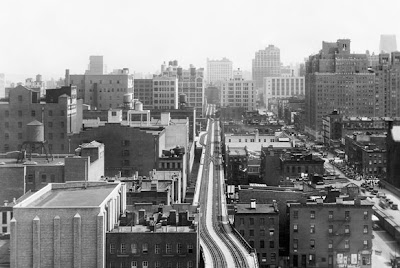The line passed through warehouses for the purpose of delivery and collection of freight
The High Line elevated railroad was used to transport freight along the Westside waterfront, replacing the street-level tracks at 10th and 11th Avenues that justifiably earned the nickname "Death Avenue." Built in 1929 at a cost of $150 million (more than $2 billion in today's dollars), it originally stretched from 35th Street to St. John's Park Terminal, now the Holland Tunnel rotary. Partially torn down in 1960 and abandoned in 1980, it now stretches from Gansevoort almost to 34th Street, mostly running mid-block, so as to avoid dominating an avenue with an elevated platform.
* Constructed 1929-1934
* Spans 22 blocks
*1.45 miles long
* 6.7 acres of space atop elevated rail track
* 30-60 feet wide and 18-30 feet high
*Built to support 2 fully loaded freight trains
* Primary construction materials: steel and reinforced concrete
* Owner: The City of New York
In its abandonment, the High Line became something of a natural wonder, overgrown with weeds and even trees, accessible only to those who risked on private property. However, bold and imaginative plans are underway, led by the Friends of the High Line, to turn it into a park, open to the public - the first phase being due to open next spring.
 Showing the corner of Gansevoort & Washington Streets in the Meatpacking District, the High Line's southern terminus. This will be the site of a major access point and street-level plaza.
Showing the corner of Gansevoort & Washington Streets in the Meatpacking District, the High Line's southern terminus. This will be the site of a major access point and street-level plaza.Friends of the High Line believes the historic High Line rail structure offers New Yorkers the opportunity to create a one-of-a-kind recreational amenity: a grand public promenade that can be enjoyed by all residents and visitors to New York City. It will be proof New York City no longer casts aside its priceless transportation infrastructure but instead creates bold new uses for these monuments to human power and ambition.






No comments:
Post a Comment